City Farmer's Country Lane Reduces Rain Water Discharge to Vancouver's Storm Sewers
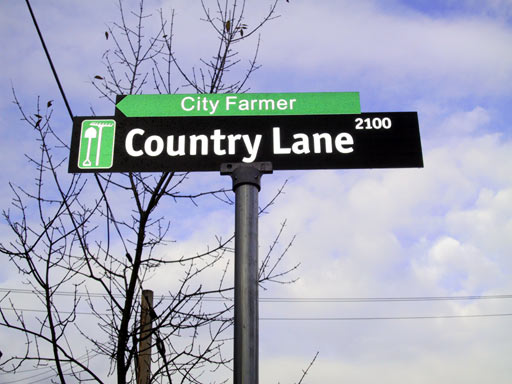
"The Country Lane is designed to provide a rural aesthetic while reducing environmental impacts and discharges to the City's storm sewer system. The design will allow rain water to percolate over vegetation and through the ground, providing natural drainage. Increased vegetation will filter storm water and may improve air quality."
Vancouver City Council passed a report to fund three demonstration Country Lanes. One of these leads up to City Farmer's garden (lane east of Maple, south of 5th Avenue).
Download a four page, colour, information package (1 MB PDF) on Vancouver "Country Lanes"
For more information contact:
Wally Konowalchuk, Project
Manager
604-873-7387
Wally_Konowalchuk@city.vancouver.bc.ca
City Farmer Lane
August 4, 2003
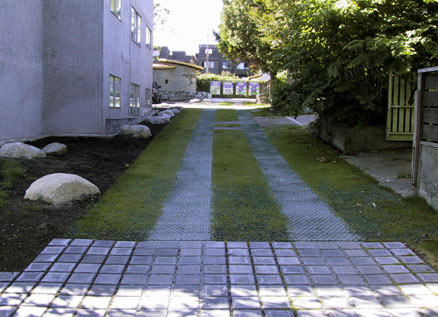
Our Country Lane is in! As we reported a year ago, City Farmer's demonstration garden was chosen as one of three pilot sites for this alternative to the growing number of asphalt lanes. The "country lane" uses materials that allow rainwater to infiltrate into the ground while providing a durable surface for vehicles to drive on. The lane calms traffic, is aesthetically pleasing and more environmentally responsible. The three demo sites were chosen because of strong community support and commitment by residents to help maintain and promote the concept. The Country Lane project is a joint initiative from the City of Vancouver's Streets Design Branch and Greenways. Greenways is responsible for the greening of pedestrian routes throughout the city. They also initiate public art and other environmental considerations on the "green ways".
The City Farmer country lane is unique among the three sites because the lane was short and narrow, so it was constructed differently. Here are the steps that streets engineer, Wally Konowalchuk, Greenways landscape designer, David Yurkovich and crew took to install our lane.
First they excavated. Typically they dig down to about four inches and then they check the subgrade soil. In our case, the subgrade was not up to snuff, so they had to dig down to about 18 inches. Next they fill the excavated area with gravel to make a strong subgrade so that garbage trucks and fire engines can roll up the lane without sinking. Then comes the structural soil. This is a mixture of 70% aggregate (3/4" rock) material mixed with 30% sandy soil. The rocks interlock to form a strong base and the sandy soil mix provides good drainage and promotes grass growth.
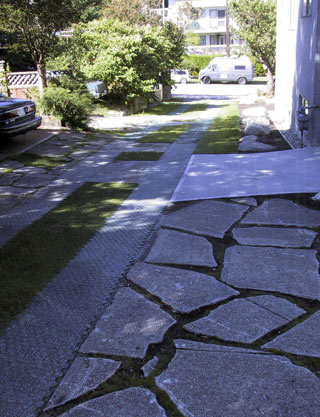
The four to six inch base of structural soil is then overlaid with Golpla also called structural grass. These plastic grids function to support vehicle weights, help to distribute the load of vehicles, prevent soil and grass root compaction and soil rutting. Some of the cells of the Golpla are filled with topsoil and grass is planted, others are filled with gravel. The topsoil provides a medium for grass growth, provides water retention during dry periods and allows drainage during storm events. Instead of the two concrete driving strips that the other lanes have, our strips are just Golpla filled with gravel. A grassy strip runs down the center of the two strips and grassy areas are also planted along the edges of the lane.
Along the sides of the country lane, especially in "connector" sites where the lane links with a neighbour's driveway or the apartment building parking lot, broken concrete was laid. The City tore up a sidewalk, excavated the pieces and brought them to the lane site. There they broke up the pieces and laid them in place atop a base of gravel with a top layer of sand. Top soil was then applied between the concrete and was planted with grass. A few of the broken pieces of sidewalk were also laid decoratively down the middle of the lane in the grassy strip. Pavers were laid at the top of the lane that meets the City Farmer driveway and a small amount of asphalt was poured in a couple of other connector sites, creating asphalt aprons.
An area alongside the apartment building was landscaped with boulders, top soil and some drainage to allow for additional water absorption. This fall, David Yurkovich will complete the landscaping, planting mostly native, waterwise plants and some ferns in the shady areas.
The country lane benefits are many. First they are greener and more attractive back lanes and they help to reduce vehicle speeds. The environmental benefits include reduced flow into the City's sewer system; natural drainage that replenishes the groundwater; natural filtration and improved air quality.
Since the lane has been installed, more and more people are walking up and down it. Previously, pedestrians would come into our garden via the driveway, now they prefer the lane. It is very inviting. We've had many people, including the fire department(!) visit our garden for the first time because they noticed the lane as they were walking or driving by and were drawn in. We hope to have a Country Lane street sign installed that should invite more people to walk up the lane. The lane leads up to our beautiful cob garden shed and outdoor oven that is nearing completion.
Country Lane Being Built - Slideshow
EcoGrid from Terrafirm Solutions
"Used as either a permeable surface for pedestrian/vehicular traffic or as a soil stabilization/mud abatement grid, EcoGrid is virtually maintenance free. This unique product provides a cost effective and perfect solution for constructing ideal surfaces for various applications. EcoGrid is water permeable and quickly becomes concealed after being covered by grass or can be filled with gravel."
City Planting Along the Country Lane
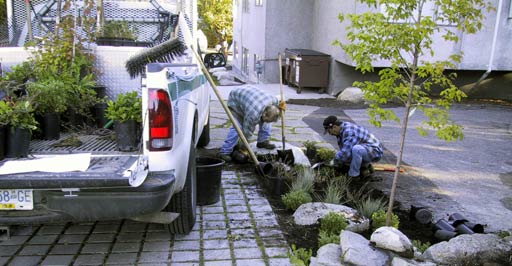
- Vine Maple (Acer Circinatum)
- Paperbark Maple (Acer Griseum)
- Blue-eyed Grass (Sisyrinchium Douglasii)
- Salal (Gaultheria Shallon)
- Western Sword Fern (Polystichum Munitum)
- Hebe (Hebe Patty's Purple)
- Red Flowering Currant (Ribes Sanguineum)
- Purple Heather (Callunia Vulgaris)
- Dull Oregon Grape (Mahonia Nervosa)
- Coastal Strawberry (Fragaria Chiloensis)
- Blue Oat Grass (Helictotrichon Sempervirens)
- Kinnikinick (Arctostaphylos Uva-ursi)
Another country lane was built in the backlane south of 700 Block of East 27th Avenue. Here is a photo of it.
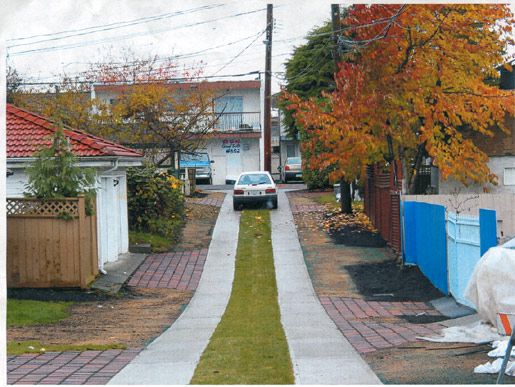
Innovative paving option approved by Vancouver city council
by Amy O'Brian
Vancouver Sun
December 20, 2004
Vancouverites now have the option of bringing a little piece of the country to their back lanes.
It won't come cheap, but the innovative lane-paving option " recently approved by Vancouver city council " will allow homeowners to pay for an aesthetically pleasing and environmentally friendly lane design that is said to slow traffic and chase away criminal activity.
"This is very exciting," Councillor Anne Roberts said moments before the proposal was passed unanimously by council last week.
"This is going to be great for the city." During the same meeting, council also agreed to change the standard lane treatment to a less expensive, more environmentally friendly design comprising a strip of asphalt down the centre with grass fringes.
The previous lane standard was wallto-wall asphalt, with nowhere for rainwater to go, except storm drains.
The country-lane treatment, as it's been dubbed by the city, is the greenest lane option, but it's also the most expensive. With a cost of approximately $96,000 per block, the country lane costs about four times as much as the so-called centre-strip option, and twice as much as the full-width option.
Residents are on the hook for about 70 per cent of the bill, but payments are spread over 15 years and added to their property taxes.
David Desrochers, streets design engineer for the City of Vancouver, acknowledges the country lane might be a hard sell, but said his department has been getting inquiring calls about the project since the city, at its own expense, installed three experimental country lanes around town.
Desrochers hopes people will be willing to pay the extra cost once they see the attractiveness of the design and realize the spin-off benefits.
"People like the green. They like the way the strips calm the traffic. In one area, they liked the way it chased away the prostitutes just because it's so different," Desrochers said. "It looks well cared for, so undesirable activity is no longer found in that lane."
The lane, at East 27th and Fraser Street, has interlocking, permeable pavers at both entrances, two thin strips of concrete down the middle, and grass on the edges and between the strips.
The pilot project won the American Public Works Association's 2003 Technical Innovation Award.
The country-lane design allows for more than 90 per cent of rain water to be absorbed directly into the ground, which eases the load on the city's sewer system and increases the amount of vegetation in urban environments.
In comparison, the city's former paving standard, the full-width lane option, absorbed zero per cent of rain water and sent it rushing into the city's storm drains. The city's new standard, the centre-strip design, absorbs 60 to 70 per cent of storm water and costs half as much as the fullwidth option.
In its report to council, the city's engineering department said it expects 20 to 25 new lanes to be constructed each year, but 'only a couple' are likely to be country lanes.
For any type of lane change to take place, at least two-thirds of residents whose homes are on a lane must sign a petition saying they would like a lane improvement.
Vancouver paves the way for country lanes The old standard back lane gives way to esthetically pleasing, environmentally friendly designs that incorporate grasses.
After exenstive testing and trial installations, city staff came up with mixes of material and design that would withstand the rigours of garbage trucks and traffic while lending back alleys a country look. The most striking feature, (the 2700 block of Yale,) is the grassed median strip.
Are you worried about exam 70-452 and exam 70-450? Check out our latest resources like examcollection 70-640 and 70-652 pdf for practice with definite guarantee of 70-513 vce.
Discussion Forum
City Farmer's Urban Agriculture
Discussion Forum

![[new]](new01.gif)
